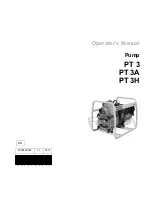
Dress your harness by starting in the middle and working your way toward the ends of cable
bundles, keeping wires parallel for a neat appearance. Dress the wires to each accessory working from the
cable bundle, making sure to leave some slack (service loop) when you make the final terminations. The
Power Center has backing nuts on all stud terminals. Be sure that all nuts, including the backing nuts, are
properly tightened as you complete the connections.
6.
TESTING
Once you have completed installation of your wire kit, make sure the Ignition Switch and all
accessories are turned OFF. The battery should be disconnected and fully charged to at least 12.5 volts.
You may want to use a battery charger or maintainer during testing. IF YOU BLOW A FUSE ALWAYS
REPLACE THE FUSE WITH THE SAME AMP RATING.
6.1
With the battery disconnected, use an ohm meter to check for shorts between the positive and
negative battery cables. Resistance should be greater than 100 ohms. A reading of less than 100
ohms indicates a possible serious short or wiring error that must be investigated and corrected
before proceeding. Otherwise, connect your battery to begin testing the system.
6.2
Check circuits that do not require the ignition key as follows.
6.2.1
Verify all brake lights, including the center (third) brake light, illuminate when the brake pedal is
depressed. Note that the third brake light will flash the first time the brake is depressed but won’t
flash again unless the brake is released for 30 seconds.
6.2.2
Turn on the parking lights (Headlight Switch). Verify dash lights, taillights, and front parking
lights are on. Set the dash lights for desired brightness using the built-in dimmer control located on
the Power Center’s Control Board to the right of the terminal strip.
6.2.3
The red Status LED on the Power Center will flash about once every 2 seconds whenever any
switch input is active. Rapid flashing indicates an output fault (short or overload) that should be
investigated and corrected.
6.2.4
Headlights should turn on with the Headlight Switch and the Dimmer Switch should operate the
high beams.
6.2.5
Turn on emergency flasher (hazard lights) and verify all four front and rear signals flash.
6.2.6
Verify the horn sounds when the horn button is depressed.
6.2.7
Verify the keyless entry (electric) door locks operate (if equipped). Approach lighting should
function as described in the Keyless Entry section.
6.2.8
Verify the dome light is gradually illuminated when a door is opened and dims to off when doors
are closed.
6.3
Check accessory circuits. Turn the Ignition Switch to the Accessory position.
6.3.1
Verify the wipers and radio operate. Accessory power should also be available at the power point
receptacle (if equipped).
6.3.2
Stay clear of the windows and window mechanisms while verifying the power windows operate up
and down correctly. Verify the automatic (1-touch) down function works by momentarily pressing
each window down switch. The 1-touch feature is not designed to work in the up direction. If the
up and down switches work backwards, either the window switch OR window motor wires are
reversed. If the automatic function works in the up direction but not in the down direction, then
the wires to the window switch AND the window motor are reversed. Correct any window switch
or motor wiring as required and repeat the test until both windows operate correctly.
6.3.3
Close the doors then turn the Ignition Switch to the off position. Accessory power will remain on
(radio and power windows will operate) until a door is opened. If a door is not opened, accessory
power will turn off automatically in a few minutes. Depending on light conditions, the headlights
may come on when the key is turned off. In dark or low light conditions, the system is designed to
turn on the headlights and illuminate the surrounding area for exiting the vehicle. When a door is
opened, the signal lamps will also turn on for additional lighting. This exit lighting will
automatically turn off in about 30 seconds. The headlight turn-off delay can be changed, see
section 7 below.


























